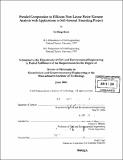| dc.contributor.advisor | Andrew J. Whittle. | en_US |
| dc.contributor.author | Hsieh, Yo-Ming, 1973- | en_US |
| dc.contributor.other | Massachusetts Institute of Technology. Dept. of Civil and Environmental Engineering. | en_US |
| dc.date.accessioned | 2005-10-14T20:28:10Z | |
| dc.date.available | 2005-10-14T20:28:10Z | |
| dc.date.copyright | 2004 | en_US |
| dc.date.issued | 2004 | en_US |
| dc.identifier.uri | http://hdl.handle.net/1721.1/29423 | |
| dc.description | Thesis (Ph. D.)--Massachusetts Institute of Technology, Dept. of Civil and Environmental Engineering, 2004. | en_US |
| dc.description | Includes bibliographical references. | en_US |
| dc.description.abstract | Reliable prediction and control of ground movements represent an essential component of underground construction projects in congested urban environments, to mitigate against possible damage to adjacent structures and utilities. This research was motivated by the construction of a large underground cavern for the Rio Piedras station in San Juan, Puerto Rico. This project involved the construction of a large, horseshoe-shaped cavern (17m wide and 16m high) in weathered alluvial soils. The crown of the cavern is located less than 5.5m below existing buildings in a busy commercial district. Structural support for the cavern was provided by a series of 15 stacked drifts. These 3m square-section galleries were excavated mainly by hand and in-filled with concrete, while a compensation grouting system was designed to mitigate effects of excavation-induced ground movements on the overlying structures. Unexpectedly large settlements occurred during drift construction and overwhelmed the grouting system that was intended to compensate for tunnel-induced movements. Although two dimensional, non-linear finite element analyses of the stacked- drift construction suggest that movements exceeding 100mm can be expected, the 2-D representation of excavation and ground support is overly simplistic and represents a major source of uncertainty in these analyses. Massive computational efforts make more comprehensive 3-D models of the construction sequence completely impractical using existing finite element software with direct or iterative solver methods. | en_US |
| dc.description.abstract | (cont.) This thesis develops, implements, and applies an efficient parallel computation scheme for solving such large-scale, non-linear finite element analyses. The analyses couple a non- overlapping Domain Decomposition technique known as the FETI algorithm (Farhat & Roux, 1991) with a Newton-Raphson iteration scheme for non-linear material behavior. This method uses direct factorization of the equilibrium equations for sub-domains, while solving a separate interface problem iteratively with a mechanically consistent, Dirichlet pre- conditioner. The implementation allows independence of the number of sub-domains from the number of processors. This provides flexibility on mesh decomposition, control between iterative interface solutions and direct sub-domain solutions, and load balance in shared heterogeneous clusters. The analyses are performed with the developed code, FETI- FEM (programmed in C++ and MPI) using syntax consistent with pre-existing ABAQUS software. Benchmark testing on a Beowulf cluster of 16 interconnected commodity PC computers found excellent parallel efficiency, while the computation time scales with the number of finite elements, NE, according to a power law with exponent, p = 1.217. Parallel 3-D FE analyses have been applied in modeling the drift excavation, primary lining and infilling for the stacked-drift construction assuming a simplified soil profile. The resulting FE model comprised approximately 30,000 20-noded quadratic displacement-based elements, representing almost 400,000 degrees of freedom (at least one order of magnitude larger than any prior model reported in the geotechnical literature) and was sub-divided into 168 sub-domains ... | en_US |
| dc.description.statementofresponsibility | by Yo-Ming Hsieh. | en_US |
| dc.format.extent | 381 p. | en_US |
| dc.format.extent | 15548917 bytes | |
| dc.format.extent | 15548718 bytes | |
| dc.format.mimetype | application/pdf | |
| dc.format.mimetype | application/pdf | |
| dc.language.iso | eng | en_US |
| dc.publisher | Massachusetts Institute of Technology | en_US |
| dc.rights | M.I.T. theses are protected by copyright. They may be viewed from this source for any purpose, but reproduction or distribution in any format is prohibited without written permission. See provided URL for inquiries about permission. | en_US |
| dc.rights.uri | http://dspace.mit.edu/handle/1721.1/7582 | |
| dc.subject | Civil and Environmental Engineering. | en_US |
| dc.title | Parallel computation in efficient non-linear finite element analysis with applications to soft-ground tunneling project | en_US |
| dc.type | Thesis | en_US |
| dc.description.degree | Ph.D. | en_US |
| dc.contributor.department | Massachusetts Institute of Technology. Department of Civil and Environmental Engineering | |
| dc.identifier.oclc | 56140153 | en_US |
